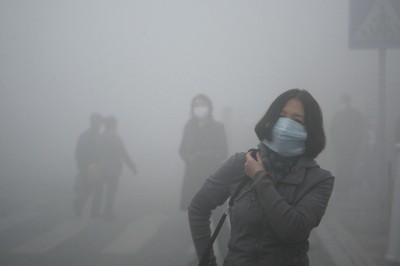Environmental History, Urban Pollution and China’s Cities of Smog

Cities are the monsters of civilization, the accrual of various factors of organisation that stress development and advancement. The latter two terms are often impossible to gauge except by comparison with other cities or States. We are left with the consequences of these thanatic drives, where life will itself suffer because the better variant of it is supposedly around the corner.
This means the pollution of waterways from the belching efforts of progress. It means dangerously high levels of invasive, cardiovascular threatening dust particles. It means a thriving industry of masks, and a city populace looking distinctly like platoons of bacteriological weapons inspectors. These problems are merely the new, grander manifestations of old.
The human species has been rather expert in the business of pollution for millennia, the epitome of which is the centralising, toxic spilling city. In May this year, the World Health Organisation released data showing that more than 80 per cent of cities across the globe face prohibitively unhealthy air. Levels of ultra-fine particles of less than 2.5 microns (PM2.5s) were found to be highest in India, a country having 16 of the world’s 30 most polluted cities.[1]
For all that, the traditional assumption that Homo sapiens only became industrially rapacious to the environment after the nineteenth century, leaving the earth’s atmosphere to its gradual doom, is a neat fallacy. Much of a head start was already being given in the days of antiquity.
Célia Sapart of Utrecht University, along with a team of researchers from the US and Europe numbering 15, found in 2012 that a two-hundred year period between the zenith of the Roman Empire and China’s Han dynasty saw much earlier contributions to greenhouse cases than thought. In the scheme of things, these anthropogenic stabs at the environment were on a pygmy scale to what took place after 1750 – but the aspiration was already there.
As the team contribution to the journal Nature observed, “Atmospheric methane concentrations have varied on a number of timescales in the past, but what has caused these variations is not always understood.”[2]
What the researchers found in examining 1,600 foot-long ice cores taken from Greenland was that two civilizations were particularly busy on the score of pollutants, with methane being the notable culprit. Large-scale agriculture, and extensive metallurgy around 100 B.C., made their fair share.
As Sapart explained, “The ice core data show that as far back as the time of the Roman Empire, human [activities] emitted enough methane gas to have an impact on the methane signature of the entire atmosphere.”[3]
The Romans of antiquity kept methane producing livestock (goats, sheep, cows) in decent number; the Chinese of the Han period engaged in an expansion of rice production, a process also responsible for the production of methane.
Rates of deforestation “show a decrease around AD 200, which is related to drastic population declines in China and Europe following the fall of the Han Dynasty and the decline of the Roman Empire.” When human populations fall off, environments, sadly, improve.
No country illustrates these problems better than China. China, assemblage of miracles, growth and the desire to outpace rivals; where things are done to gargantuan scale, often with selective environmental oversight. The cost to citizens, not to mention their environs, has become telling.
As Greenpeace East Asia notes through the toxic cloud darkly, “Millions of people in China are breathing a hazardous cocktail of chemicals everyday. These chemicals are caused by coal-fired power plants, factories and vehicles, and are responsible for heart disease, stroke, respiratory illnesses, birth defects and cancer.”[4]
Despite the seemingly dreary nature of the observation, attempts have been made in China to rein in the problem. Again, treating it as much as a competition as a matter of civic duty, the authorities managed to push numerous cities out of the top 30. The country now only claims to have five in the list.
Well and good, which is what made this month rather jarring. Stifling, lethal smog engulfed Beijing, and good deal of northern China. Images of the cities proved to be post-apocalyptic. Flights were cancelled, highways shut.
In a recent study by researchers at Nanjing University noted in the South China Morning Post, covering 74 cities and the deaths of 3.03 million people recorded in 2013, a staggering 31.8 per cent were attributable to smog. China’s cities have become death catchments.
The response to this toxic mayhem? The levying of environmental protection taxes on industry, to commence in 2018. “Tax revenue,” came the dry statement from the Finance Ministry, “is an important economic means to promote environmental protection.”[5]
The rates, outlined by Reuters, will entail 1.2 yuan ($0.17) per unit of atmospheric pollution, with 1.4 yuan per unit of water pollution, and 5 yuan per tonne of coal waste. “Hazardous waste” will attract a tax of 1,000 yuan per tonne.
These amounts, or details of the new law, are hardly being delivered from a unified front. The bureaucrats are fighting acrimonious turf wars, from the State Taxation Administration to the Ministry of Environmental protection. In this age, it will take far more than levies to reduce the pollution of cities, a problem that was even faced, albeit unsatisfactorily, in Han China and ancient Rome.
Dr. Binoy Kampmark was a Commonwealth Scholar at Selwyn College, Cambridge. He lectures at RMIT University, Melbourne. Email: [email protected]
Notes
[1] https://www.theguardian.com/environment/2016/may/12/air-pollution-rising-at-an-alarming-rate-in-worlds-cities

